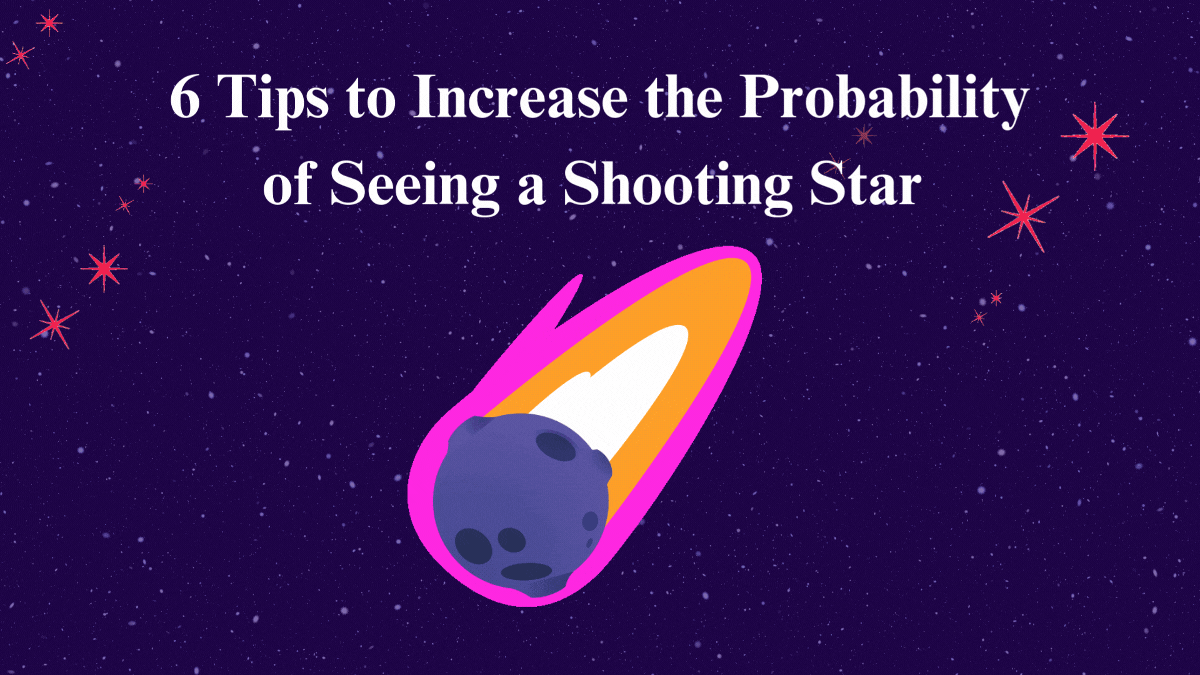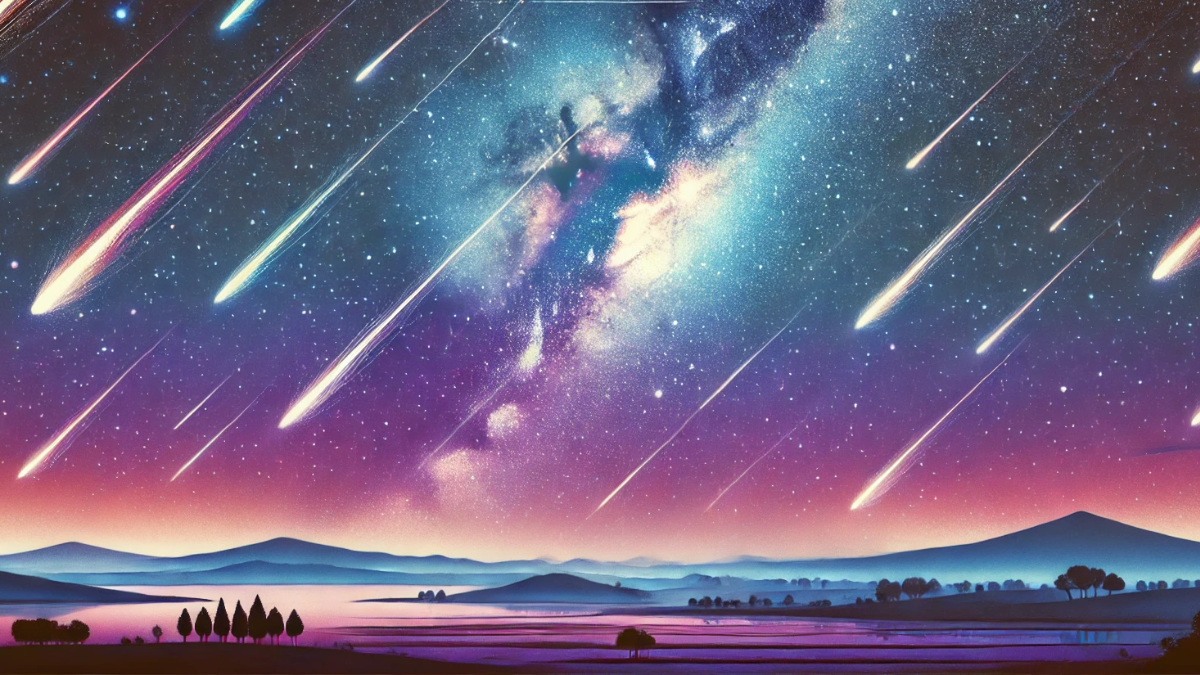How rare is it to spot a shooting star in the sky? These seemingly magical events in fact constantly take place in outer space. Small rocky or metallic debris also called meteors aka what we call as shooting stars constantly enter Earth’s atmosphere. But, the probability of seeing a shooting star depends on factors like time, location, weather & more. So if you have never seen a shooting star or perhaps wish to witness one again, this article shall help you find out the best timings & dates in 2025 to see a shooting star in the sky. We will also find out what’s the probability of seeing a shooting star in the sky and the factors that influence it.

.
What are Shooting Stars?
A shooting star is not a star but rather a meteor that looks like a streak of light as it travels the Earth’s atmosphere with a high speed of 11 to 70 km/s. The glow is caused by intense friction with atmospheric gases, primarily in the mesosphere (altitude 50-85 km), heating the meteor to thousands of degrees and causing rapid ablation. Most meteors vaporize within a fraction of a second, though larger ones may last a few seconds.
.
What’s the Probability of Seeing a Shooting Star?
The probability of seeing a shooting star depends on factors like time, location and atmospheric conditions. For example, during the last meteor shower called Quadrantids, one could see as many as 25-30 shooting stars per hour. This number might drop to 8 to 15 during normal days.
| 6 Tips to Increase Your Chances of Seeing a Shooting Star | ||
| Factor | Details | Tips to Improve Your Chances |
| Location🚩 | Dark, rural areas are best. City lights and air pollution reduce visibility by making the sky too bright for faint meteors. | Visit dark-sky reserves, rural areas, or mountains. Use live light pollution maps or “Dark Site Finder” (for U.S.A) to locate the least light-polluted spots. |
| Time⌚ | The best viewing window is 2:00 AM to 5:30 AM.. | Plan for predawn hours. Allow 15–20 minutes for your eyes to adapt to darkness. Stay off your phone or bright lights. |
| Weather🍃 | Clear skies are essential. Clouds, rain, poor air quality and haze block or reduce visibility. | Choose nights with clear skies and low humidity. Post-rain skies are often clearer. Higher altitudes like mountains offer better clarity. |
| Viewing Spot👁️ | Unobstructed views of the sky improve visibility. | Pick open spaces with 360° sky views like rooftops or fields. |
| Meteor Shower Peaks💫 | Major showers like Geminid or Perseid can produce up to 75 meteors per hour. | Track meteor shower calendars for peak dates and times. |
| Patience💖 | Meteors may not appear instantly. Bright screens and rushing reduce chances. | Pause, breathe, and let the night sky remind you that beauty takes time to reveal itself. |
.
3 Key Factors that Decide the Probability of Seeing a Shooting Star?
Spotting a shooting star is considered to be a lucky charm and seeing one sure feels like a dream come true to many of us, right? But sadly, due to the air & light pollution we are surrounded with, this dream often seems a bit far fetched. But thankfully, you can change that. Here are the top factors that decide the probability of spotting a shooting star – be it the best timings to see a shooting star or the best place & the best dates to see one, here’s all you need to know.
.
Location: Where is the best place to see a shooting star?
A key necessary condition to see a shooting star is finding a place that is far from heavily light-polluted cities. Dark, rural areas far away from the city’s constant air & light pollution offers you the best chance to spot a shooting star. This happens because city lights create a bright glow that makes it next to impossible to spot faint meteors or shooting stars due to a lack of contrast or darkness in the sky.
Air pollution also largely decides the probability of finding a shooting star in the sky. Dust, smog, and haze in the atmosphere scatter light and limit visibility, especially near industrial or densely populated areas.
.
How Time Influences Your Chance of Seeing Shooting Stars
Moving on to our next key condition to see a shooting star – time. Generally the best time to find shooting stars in the sky is between 02:00 AM to 05:30 AM. Since during the night especially the predawn, Earth’s rotation brings your location into the path of incoming meteors.
Choose a high-rise place such as a rooftop, a terrace or a mountain top that allows you to see the sky in an unobstructed way. Lay flat on your back and observe the sky patiently. Avoid using your phone or any bright light source, as it can disrupt your night vision.
Give yourself at least 15-20 minutes to adapt to the darkness for optimal visibility. For the best results, plan your stargazing during peak meteor shower events when shooting stars are more frequent. Keep an eye on the weather forecast to ensure a clear, cloud-free sky, as even partial cloud cover can significantly reduce your chances of spotting meteors. Lastly, dress comfortably and bring a blanket or sleeping bag to stay warm, especially if the temperature drops during the early hours. With patience and the right conditions, you’re likely to catch some mesmerizing shooting stars lighting up the sky:))
However, nothing beats the night of meteor showers. Some meteor showers like Geminid witness as many as 70 shooting stars per hour. This significantly increases your probability to see shooting stars. So let’s have a look at the most probable dates & timings to find shooting stars further.
.
Meteor Shower Events Dates & Timings 2025
Meteor showers are formed when Earth passes through a trail of debris left behind by a comet. This is a cyclical event that occurs every year on nearly the same dates. If you want the best chance to see a shooting star, these meteor shower events are not to be missed.
| Meteor Shower | Best Viewing | Peak Date of Observation in 2025 | No. of Shooting Stars Per Hour | Direction |
| Quadrantid | Predawn | January 3rd – 4th | 25 | N |
| Lyrid | Predawn | April 16th to 25th | 10 | S |
| Eta Aquarid | Predawn | April 15th & May 27th-28th | 10 | SE |
| Delta Aquarid | Predawn | July 29th-30th | 10 | S |
| Perseid | Predawn | August 17th–24th | 50 | NE |
| Draconid | Late evening | October 6th-10th | 6 | NW |
| Orionid | Predawn | Oct 2nd to November 7th | 15 | S |
| Northern Taurid | Late evening | November 9th-12th | 3 | S |
| Leonid | Predawn | November 17th-18th | 10 | S |
| Andromedid | Late evening | November 25th–27th | 5 | S |
| Geminid | All night | December 13th–14th | 75 | NE |
| Ursid | Predawn | December 21st | 5 | N |
Meteor showers get their name after the constellations where they seem to come from. For instance, Geminid, one of the most powerful meteor showers, is named after the constellation of Gemini. These meteor showers are active from December 1 to December 21st but the peak arrives around December 12th-14th.
Finding shooting stars during meteor showers significantly increases the probability of seeing a shooting star, not only because the number of meteors per hour rises but also because their glowing streaks appear to radiate from a specific point in the sky, called the radiant. This makes it easier to spot shooting stars, as you can focus your attention on this area of the sky. While meteors can streak across any part of the sky, knowing the radiant greatly enhances your chances of seeing a shooting star.
.
How Weather Impacts the Probability of Seeing a Shooting Star
The probability of seeing a shooting star depends heavily on the weather. Clear, dark skies are non-negotiable for stargazing, as even light clouds can obscure your view of meteors streaking through the atmosphere. Overcast conditions, of course, make it impossible. Humidity leading to high moisture levels can create a hazy sky, dimming faint meteors and reducing visibility. Air quality as we mentioned earlier is another often-overlooked factor. Pollution, dust, or wildfire smoke scatters light and creates a murky view of the night sky, making shooting stars harder to spot. Elevated areas, like hills or mountains, not only help you escape light pollution but also improve clarity by placing you above low-lying haze or fog.
.
While gazing at the stars and pondering the mysteries of the night sky, have you ever wondered how celestial events like shooting stars connect to the deeper realms of astrology? Explore the fascinating intersections between astronomy and astrology to uncover how cosmic alignments influence our lives. And if dreams intrigue you too, discover the meanings behind animals appearing in your dreams







